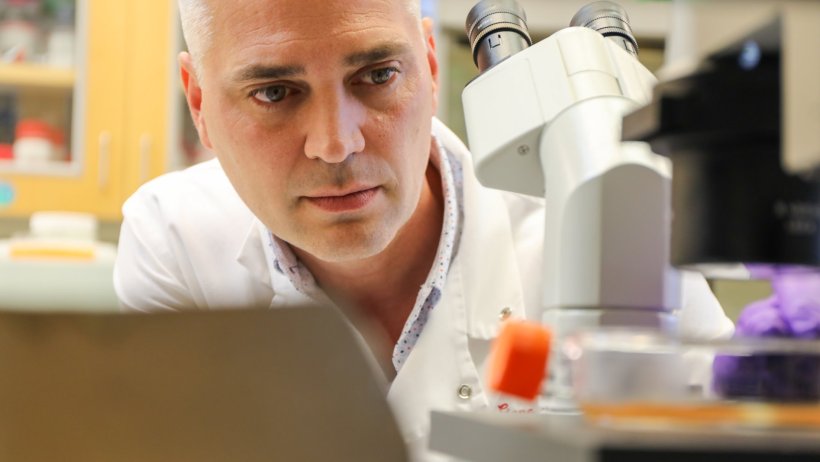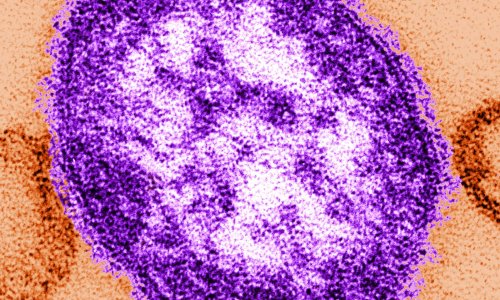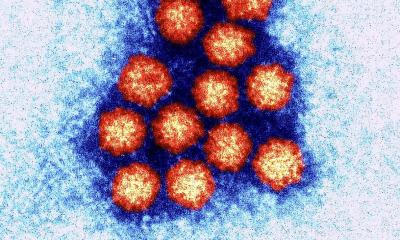
Image source: OHSU; photo: Christine Torres Hicks
News • Immunology
“One and done”: promise for a universal influenza vaccine
US researchers use an innovative vaccine platform to target interior of virus; scientists validate theory using 1918 flu virus
New research led by Oregon Health & Science University (OHSU) reveals a promising approach to developing a universal influenza vaccine — a so-called “one and done” vaccine that confers lifetime immunity against an evolving virus. The study, published in the journal Nature Communications, tested an OHSU-developed vaccine platform against the virus considered most likely to trigger the next pandemic.
Researchers reported the vaccine generated a robust immune response in nonhuman primates that were exposed to the avian H5N1 influenza virus. But the vaccine wasn’t based on the contemporary H5N1 virus; instead, the primates were inoculated against the influenza virus of 1918 that killed millions of people worldwide. “It’s exciting because in most cases, this kind of basic science research advances the science very gradually; in 20 years, it might become something,” said senior author Jonah Sacha, PhD, professor and chief of the Division of Pathobiology at OHSU’s Oregon National Primate Research Center. “This could actually become a vaccine in five years or less.”
The problem with influenza is that it’s not just one virus. Like Sars-CoV-2, it’s always evolving the next variant and we’re always left to chase where the virus was, not where it’s going to be
Jonah Sacha
Researchers reported that six of 11 nonhuman primates inoculated against the virus that circulated a century ago — the 1918 flu — survived exposure to one of the deadliest viruses in the world today, H5N1. In contrast, a control group of six unvaccinated primates exposed to the H5N1 virus succumbed to the disease. Sacha said he believes the platform “absolutely” could be useful against other mutating viruses, including the coronavirus Sars-CoV-2. “It’s a very viable approach,” he said. “For viruses of pandemic potential, it’s critical to have something like this. We set out to test influenza, but we don’t know what’s going to come next.”
A senior co-author from the University of Pittsburgh concurred. “Should a deadly virus such as H5N1 infect a human and ignite a pandemic, we need to quickly validate and deploy a new vaccine,” said co-corresponding author Douglas Reed, PhD, associate professor of immunology at the University of Pittsburgh Center for Vaccine Research.
This approach harnesses a vaccine platform previously developed by scientists at OHSU to fight HIV and tuberculosis, and in fact is already being used in a clinical trial against HIV. The method involves inserting small pieces of target pathogens into the common herpes virus cytomegalovirus, or CMV, which infects most people in their lifetimes and typically produces mild or no symptoms. The virus acts as a vector specifically designed to induce an immune response from the body’s own T cells.
This approach differs from common vaccines — including the existing flu vaccines — which are designed to induce an antibody response that targets the most recent evolution of the virus, distinguished by the arrangement of proteins covering the exterior surface. “The problem with influenza is that it’s not just one virus,” Sacha said. “Like Sars-CoV-2, it’s always evolving the next variant and we’re always left to chase where the virus was, not where it’s going to be.”
The immunity induced by the vaccine was sufficient to limit virus infection and lung damage, protecting the monkeys from this very serious infection
Simon Barratt-Boyes
The spike proteins on the virus exterior surface evolve to elude antibodies. In the case of flu, vaccines are updated regularly using a best estimate of the next evolution of the virus. Sometimes it’s accurate, sometimes less so. In contrast, a specific type of T cell in the lungs, known as effector memory T cell, targets the internal structural proteins of the virus, rather than its continually mutating outer envelope. This internal structure doesn’t change much over time — presenting a stationary target for T cells to search out and destroy any cells infected by an old or newly evolved influenza virus.
To test their T cell theory, researchers designed a CMV-based vaccine using the 1918 influenza virus as a template. Working within a highly secure biosafety level 3 laboratory at the University of Pittsburgh, they exposed the vaccinated nonhuman primates to small particle aerosols containing the avian H5N1 influenza virus — an especially severe virus that is currently circulating among dairy cows in the United States. Remarkably, six of the 11 vaccinated primates survived the exposure, despite the century-long period of virus evolution. “It worked because the interior protein of the virus was so well preserved,” Sacha said. “So much so, that even after almost 100 years of evolution, the virus can’t change those critically important parts of itself.”
The study raises the potential for developing a protective vaccine against H5N1 in people. “Inhalation of aerosolized H5N1 influenza virus causes a cascade of events that can trigger respiratory failure,” said co-senior author Simon Barratt-Boyes, PhD, professor of infectious diseases, microbiology and immunology at Pitt. “The immunity induced by the vaccine was sufficient to limit virus infection and lung damage, protecting the monkeys from this very serious infection.”
By synthesizing more up-to-date virus templates, the new study suggests CMV vaccines may be able to generate an effective, long-lasting immune response against a wide suite of new variants. “I think it means within five to 10 years, a one-and-done shot for influenza is realistic,” Sacha said.
The same CMV platform developed by OHSU researchers has advanced to a clinical trial to protect against HIV, and a recent publication by those scientists suggests it may even be useful targeting specific cancer cells. The HIV clinical trial is being led by Vir Biotechnology, which licensed the vaccine platform from OHSU. Sacha sees the development as the latest in the rapid advance of medical research to treat or prevent disease. “It’s a massive sea change within our lifetimes,” Sacha said. “There is no question we are on the cusp of the next generation of how we address infectious disease.”
In addition to OHSU, research institutions involved in the study included the Tulane National Primate Research Center, the University of Pittsburgh, the University of Washington, and the Washington National Primate Research Center at the UW.
Source: Oregon Health & Science University
19.07.2024











